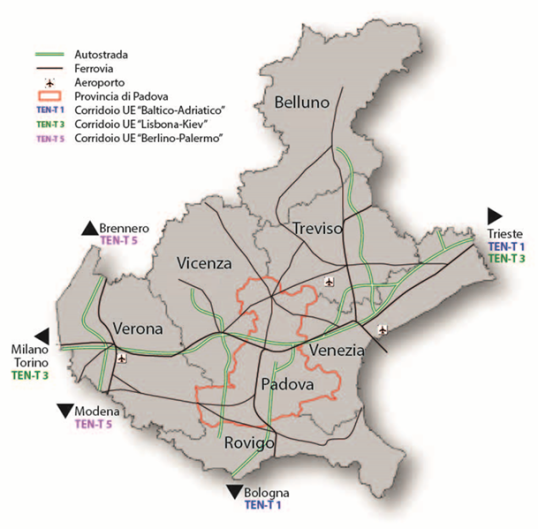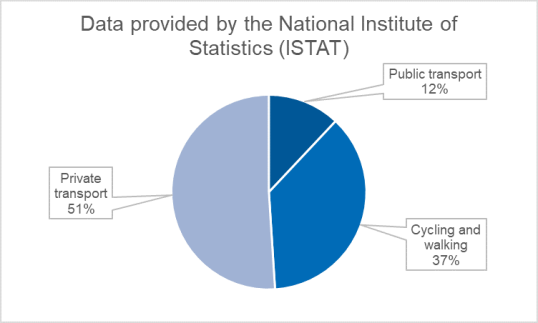- Topic
- Urban mobility planning
- Country
- Italy
- Resource type
- Case study
A Sustainable Urban Mobility Plan (SUMP) is a strategic planning tool including a long-term vision for the urban mobility system that aims to achieve a set of environmental, economic and social objectives. This is supported by a definition of actions aiming to improve the effectiveness and efficiency of the mobility system and to ensure its integration with urban and territorial development. In addition, the SUMP approach encourages closer cooperation between the various institutional levels, as well as a strengthened collaboration between neighbouring urban areas.
In contrast to more traditional approaches to transport planning, the SUMP places particular emphasis on the involvement of city residents and the coordination of planning policies and instruments between different areas of competence of the public authority (e.g. transport with town planning, environment, economic development, social services, health, safety, energy, etc). Moreover, it is expected to provide a clearer representation of transport costs and to take account of wider societal costs and benefits with the aim of “internalising costs”, thus highlighting the advantages deriving from the adoption of greener and healthier transport choices.
The SUMP of Padova (Padua) and its metropolitan area follows the guidelines developed for the European Commission in 2014 and those issued by the Italian Ministry of Infrastructure through the Ministerial Decree of 4 August 2017.
Context
Padova lies in the North-Eastern corner of the Po Valley, Northern Italy; one of the areas in Europe that is most challenging in terms of improving its air quality.
The Municipality of Padova, in collaboration with the Municipalities of the Padova Metropolitan Conference, commissioned the preparation of a SUMP to cover the Municipality of Padova with its 210 401 inhabitants (2015) and the surrounding 19 municipalities that are part of the Metropolitan Conference of the Padova metropolitan area (known as ‘Co.Me.Pa.’). In total, there are over 450 000 inhabitants in the area of 400 km2 approx.
Padova is a major centre for services, tourism and culture, and is surrounded by a large, dynamic area that has experienced significant growth in recent years and, as such, is a significant generator of travel. The city is well connected with neighbouring cities in the Veneto region, and with long-distance transport networks.
The decision that the SUMP would cover the Padova metropolitan area was based on the need to take account of all of the factors that generate demand for the mobility of people and goods in the city. Moreover, the need to draft a SUMP at the inter-urban level was reiterated in the recent Guidelines for the drafting of SUMPs issued by the Italian Ministry of Infrastructure in a Ministerial Decree from 4 August 2017.
In action
As noted above, the SUMP is required to outline the mobility vision for the whole Co.Me.Pa. area and does this for the next ten years. The objectives will be achieved by proposing a wide-ranging set of policies and measures that are coherent with one other, and which are able to operate in synergy, thus giving coherence to the definition of sustainable mobility and helping to make it tangible.
The SUMP development process follows the EU guidelines and involves various activities linked to the SUMP planning cycle. The following activities will be carried out during the SUMP implementation:
As part of phase 1:
- background analysis of Padova's transport situation, examining its strengths and weaknesses;
- field investigations to better assess local mobility issues and to identify critical issues;
- regular meetings and information exchanges with local stakeholders.
As part of phase 2:
- definition of the overall objectives, strategies and targets of the SUMP;
- definition of alternative scenarios on the basis of a transparent method, and then identification of the best SUMP scenario.
In parallel, thematic roundtables are organised by the Municipality of Padova, in order to gather further insight from the territories and stakeholders involved.
As part of phase 3:
- evaluation of the alternative scenarios;
- proposal of the SUMP to be adopted;
- specific workshop (March 2018);
- inventory of plans and projects;
- online survey.
The SUMP includes initiatives and measures in both the central urban area and the surrounding municipalities that can guide the mobility sector in the direction of greater environmental, social and economic sustainability.
Results
Analytical framework - preliminary results
Several activities have involved residents and local stakeholders, particularly a survey, thematic workshops and roundtables.
The aim of the survey was to better understand and evaluate the local mobility characteristics and to identify the critical issues and expectations of the residents and visitors of Padova and the Co.Me.Pa. municipalities, regarding mobility in the region and its impact.
The survey was hosted online by the portal of the Municipal Administration, and was also distributed using more traditional methods, such as through paper questionnaires that were distributed during the Bicycle Festival in Padova (8 April 2018). Although the results of the survey were not statistically significant, there were still a relatively good number of responses (approximately 2 500).
The participation process proved to be successful, thanks to the organisation of four thematic roundtables, focused on: (i) traffic and infrastructure; (ii) cycling and active mobility; (iii) road safety; and (iv) public transport (road and rail). The main stakeholders in the region, such as entrepreneurs, associations, representatives of the local community, etc., were invited to the meetings. Their purpose was to collect useful requests and visions from stakeholders for developing objectives for the definition of alternative scenarios.
Conclusions and recommendations
The SUMP implementation process is still ongoing and continues to deliver interesting results. The transport demand and the modal split have been calculated and updated using a multimodal transport simulation model. This was needed since the previous Urban Mobility Plan for Padova dated back to 2009 and the Regional Plan of the Veneto region has not been updated recently. The forecast of transport demand was also estimated for 2025 and 2030, compared to the situation in 2018.
The results of the modelling simulations (“Modello” in the chart below) enabled the updating of the modal share information for the Co.Me.Pa area and allowed this to be compared to the data provided by the National Institute of Statistics (“ISTAT”). The charts shown below group the modal share in the following way:
- Private transport (car and motorbike);
- Public transport (train, tramway, interurban bus and urban bus);
- Cycling and walking.
On the basis of this, plus additional data and information that was collected, the recommendations of the Reference Scenario and the Plan Scenario were to focus particularly on interventions to:
- strengthen the availability of public transport (tramway and BRT);
- develop a shared space approach and reduce road speed limits (road safety);
- define interventions on road infrastructure (e.g. adaptation/upgrading of primary road network, bypass city centres);
- improve the cycling network and services;
- enhance shared mobility schemes and practices;
- develop e-mobility and ITS measures (e.g. access control, smart parking);
- improve and further decarbonise urban logistics (e.g. through the implementation of a Low Emission Zone and a Zero Emission Zone in the city centre).
Challenges, opportunities and transferability
After Luxembourg, Italy is the EU Member State with the highest modal share for private motor vehicles. The level of private car use imposes negative economic, environmental and social externalities on local residents and visitors.
Hence, there is room for further improvement of the level of integration of urban mobility plans of individual cities across Italy; more shared and targeted actions are needed to better coordinate and manage urban planning and urban mobility to deliver sustainability objectives. The approach applied and developed in Padova and its surrounding hinterland is certainly of potential interest to the other 14 Italian metropolitan cities. In fact, the challenges and the critical issues faced by Padova are similar to those affecting other Italian medium-sized cities.
The role of participatory processes is important, since they are capable of capturing at a very early stage the mood and the opinions of local residents to ensure that their views and concerns are properly taken into account, following a transparent and shared implementation process.
Finally, regular monitoring and evaluation of the planned measures, thanks to the definition of a precise set of urban mobility indicators and the opportunity to consult target groups, represents a great opportunity to follow the implementation of the plan. The adoption of similar approaches in other cities would facilitate further comparison of different cities and contexts, as well as the exchange of good practice.
In Depth
http://www.padovanet.it/ambiente-e-territorio/trasporti-e-viabilit%C3%A0
This case study has been prepared for the European Commission however it reflects the views only of the authors, and the European Commission is not liable for any consequence stemming from the reuse of this publication.




